If you’ve ever seen buildings like the Sagrada Familia in Barcelona or St. Peter’s Basilica in Rome, it’s not hard to believe that architecture can be an art form, a cultural statement, and a piece of history all at the same time. Every building reflects the values, technology, and aspirations of its time.
At Remitly, we love to celebrate cultural diversity across borders, and understanding different styles of architecture is part of that mission. In this article, we’ll look at the major architectural trends that have shaped the world we live in now. We’ll identify key features and examine their historical context to help you appreciate the culture behind iconic buildings around the world.
Gothic architecture: reach for the sky
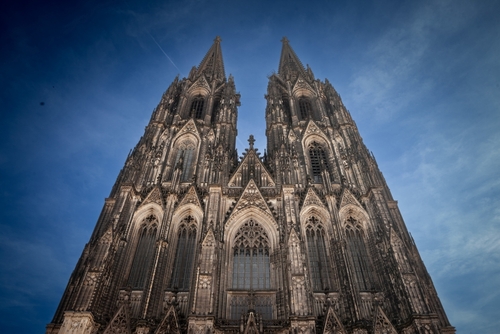
One of the most famous and easily recognizable architectural styles in the world is Gothic. If you’ve ever seen a medieval European church, you’ve probably seen this style of architecture.
Gothic architecture emerged in 12th-century France and spread across Europe until around the 16th century. It was deeply rooted in faith, and the intention was to inspire awe and make people think of God. These cathedrals were not just places of worship, but symbols of heaven on earth, with every element of the majestic buildings pointing upward toward the divine.
What makes the style so recognizable are Gothic architecture features like pointed arches, ribbed ceiling vaults, and flying buttresses. These, in particular, were a technological innovation that supported the weight of a cathedral roof and allowed buildings to be built bigger than ever before.
It also allowed huge stained-glass windows to fill the interior with colored light, making walking into these buildings an inspiring experience. At the time, Gothic cathedrals were the biggest buildings in the world, and yet they have a sense of lightness and grace that make them just as inspiring today as they were when they were built.
Famous examples
Famous examples include Notre Dame in Paris, Westminster Abbey in London, and Cologne Cathedral in Germany.
These buildings are fusions of art, faith, and the cutting-edge building techniques and technology of the time. They pushed the limits of what was possible in construction.
They were so popular that they returned in the 19th century, with neo-Gothic buildings springing up around the world, including in the US. Buildings like St. Patrick’s Cathedral in New York or Grace Cathedral in San Francisco show you Gothic architecture without having to fly to Europe.
Renaissance architecture: rebirth of classical beauty
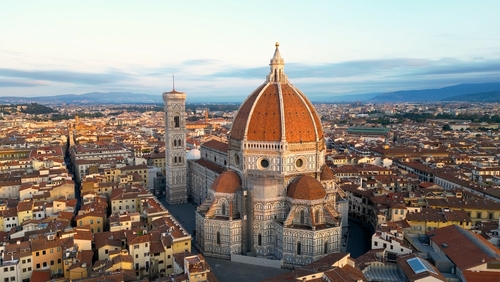
The term Renaissance means rebirth, and it describes a historical period that changed the world. From the 15th to 17th centuries, the Renaissance was an artistic, scientific, and political movement that transformed the way society worked. It involved the rediscovery of the harmony and grandeur of ancient Roman and Greek culture, and it affected architecture in a major way.
Renaissance architecture is all about symmetry, proportion, and geometry. Like the cultural rebirth it was a part of, this building style celebrated balance and order. Rounded arches, elegant columns, and magnificent domes became defining elements, shifting away from the vertical angles of Gothic cathedrals to a more classical beauty.
Architecture has always been a place where science and technology meet art, and the Renaissance was no different. Today, travelers still marvel at Brunelleschi’s dome on top of Florence Cathedral—a massive brick construction that he had to invent his own machines to build.
Italy was the birthplace of the Renaissance, and it’s still the best place to see Renaissance architecture. St. Peter’s Basilica in Rome, with its massive dome and elegant columns, is a perfect example of the style. This was a time when powerful popes and princes poured money into architectural projects. It’s left us with a legacy of incredible buildings that still move us today.
Baroque architecture: drama in stone and marble
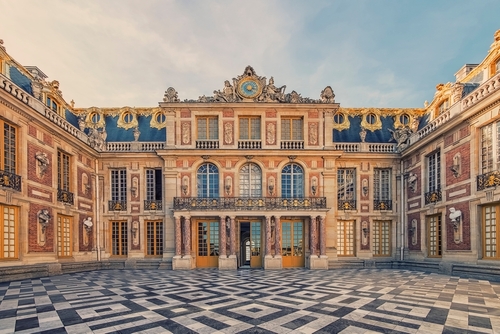
Baroque architecture is all about spectacle. It started in the 17th century and became most popular in the 18th. It’s one of the most instantly recognizable styles thanks to its flowing curves, elaborate ornamentation, and theatrical use of light and shadow. Unlike the balance and harmony of Renaissance design, Baroque buildings overwhelm the senses with sweeping staircases, gilded details, and ceilings painted with frescoes.
Cultural and political influences
This style emerged during the Protestant Reformation in northern Europe. This new religious power chipped away at the power of the Catholic Church that had ruled the continent for centuries. Baroque architecture was intended to inspire faith and reclaim that lost influence.
Powerful monarchies built Baroque palaces and churches to state their own authority and divine right to rule. In this context, architecture was a tool of persuasion, designed to impress and overwhelm.
Famous examples
Baroque buildings are all about excess, and they don’t come much more excessive than the Palace of Versailles, just outside Paris, France. St. Paul’s Cathedral is the best-known Baroque landmark in London. Vienna’s Karlskirche is a rare example of the Baroque in central Europe, where Gothic and other building styles are usually more popular.
Neoclassical architecture: democracy’s design language

The Baroque wasn’t the only building style linked with a political revolution. In the 18th and 19th centuries, the Enlightenment took hold in Europe, bringing about a dramatic reordering of society.
The divine right of kings was out, and a series of revolutions and societal shifts took place. With the aim of bringing greater representation for all people, the modern democratic state was born.
As scientific advances and the Industrial Revolution took hold, architects looked for order and balance. The style of ancient Greco-Roman buildings aligned perfectly with the Enlightenment pursuit of knowledge and progress. Ancient Greece is generally recognized as the world’s first democracy, and newly democratic governments wanted to link themselves to this legacy.
Iconic neoclassical locations
This was an era of exploration and colonization, so we find examples of this architectural style around the world. The grand façade of the British Museum in London reflects these classical ideals of knowledge and culture. Berlin’s Brandenburg Gate is a monumental arch symbolizing unity and civic pride.
Outside of Europe, the US Capitol in Washington, DC, was intended to recall the democratic ideals of ancient Greece. Other examples include El Capitolio in Cuba and the Bogor Palace in Indonesia.
Art Nouveau: nature’s organic revolution
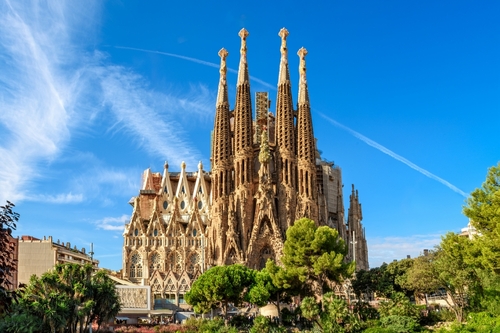
Between 1890 and 1910, a short but influential architectural movement grew in Europe. Art Nouveau intended to embrace nature and bring its beauty into buildings—replacing rigid, mechanical lines with flowing curves, asymmetrical shapes, and plant-inspired motifs. Innovative materials like wrought iron and glass allowed the creation of more organic-looking buildings.
Think of Art Nouveau as a response to the repetitive patterns of the Industrial Revolution. The aim was to bring artistry and beauty back into everyday life. In the often ugly cities of the late 19th and early 20th century, these beautiful buildings helped to soften the urban environment while also making art accessible and immersive.
Iconic destinations
This building style may have been short-lived, but it was popular. One of the best examples is Antonio Gaudí’s still unfinished Sagrada Familia Cathedral in Barcelona. The famous Paris Metro entrances also exemplify Art Nouveau style, with elegant wrought-iron curves and plantlike details.
In the US, the Carson, Pirie, and Scott building in Chicago, with its ornate cast-iron façade and botanical patterns, is a fine example.
Modernist architecture: form follows function
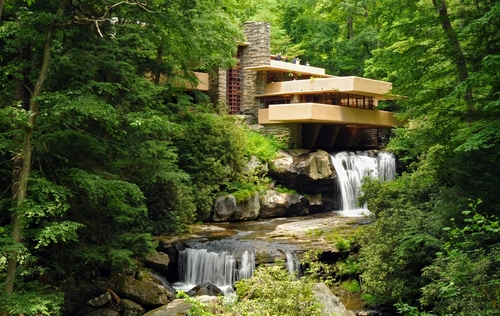
From the early to mid-20th century, Modernist architecture became one of the biggest design periods in history. The idea was based around simple, practical spaces, getting rid of ornamentation in favor of clean lines and open floor plans. Again, technology was part of this change, as large windows allowed more natural light into buildings.
This was a time of rapid industrial growth and major social shifts. Architects were inspired by mass production and the need for affordable housing after major wars as much as they were by their own artistic tastes. In the end, they created an architectural style that symbolized progress, innovation, and equality.
Famous modernist buildings
The Bauhaus building in Dessau, Germany, is a great example of form reflecting function. French architect Le Corbusier created many famous examples of this style, such as the minimalist Villa Savoye.
Frank Lloyd Wright also created minimalist masterpieces, including Fallingwater in Pennsylvania, showing how the clean lines of modernism could combine beautifully with the natural world.
This style continues to have a big influence today, with many of the buildings created then still in use. The modern office building and the idea of open-concept living spaces in homes go back to this era.
Contemporary architecture: innovation meets sustainability
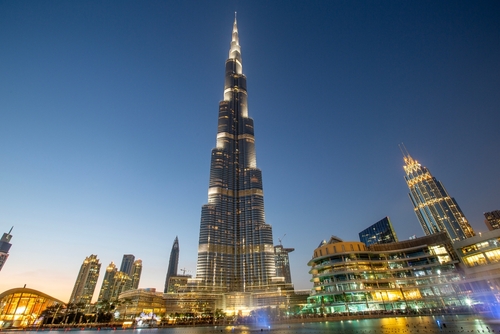
Technology has always shaped architecture, and that’s still true today. These days, though, new buildings often reflect a greater sense of responsibility toward the planet.
Sustainable materials, energy-efficient systems, and mixed-use spaces are ever more popular. Contemporary architecture focuses on sustainability and adaptability, creating spaces that are useful today while also preparing for the needs of tomorrow.
Iconic contemporary architectural destinations
The Burj Khalifa in Dubai is the tallest building in the world, and it wouldn’t have been possible just a few decades ago. Meanwhile, New York’s High Line transformed an old railway into a public park. Singapore’s Gardens by the Bay incorporates futuristic design, like supertrees that generate solar power.
As architecture moves forward, it’s no longer just a case of making a building look good. Now, contemporary architectural trends help preserve resources and adapt to changing needs as society transforms.
How to spot these styles in daily life
One of the best things about architecture is that it’s everywhere and accessible to everyone. We often don’t notice the buildings around us, especially when in a place we know well. But every city on earth has a story to tell through its architecture.
Take some time to look at the buildings around you. Notice things like window shapes, rooflines, materials, and proportions. You’ll find examples of these architectural styles, or other styles influenced by them, everywhere.
Quick guide to architectural movements
| If it looks like… | Then you’re probably looking at… | Famous examples |
| A massive stone cathedral stretching into the sky, or a castle with spiky towers and stained glass that looks like a princess might be imprisoned there | Gothic architecture | Notre-Dame (Paris), Cologne Cathedral |
| A math nerd’s dream—everything is symmetrical, domed, and columned, like ancient Rome got a fabulous makeover | Renaissance architecture | Florence Cathedral dome, St. Peter’s Basilica |
| A royal stage set dripping with gold, curvy staircases, and ceilings painted to make you look up and say “wow” | Baroque architecture | Palace of Versailles, St. Paul’s Cathedral |
| Something a government would build to look serious. Ancient Greece with a bit of botox: columns, pediments, symmetry, and very little fuss | Neoclassical architecture | US Capitol, British Museum, Brandenburg Gate |
| It grew out of a plant sketchbook, with swirly ironwork and flowers hiding in the details | Art Nouveau | Paris Metro entrances, Sagrada Família |
| A geometry lesson—all straight lines, glass, open spaces, and absolutely no frills allowed | Modernist architecture | Bauhaus building, Villa Savoye, Fallingwater |
| Something futuristic and eco-friendly, with solar panels, living walls, or daring shapes that scream “Instagram me!” | Contemporary architecture | Burj Khalifa, High Line, Gardens by the Bay |
Why architectural movements matter
Our relationship with the spaces we live in is always evolving. Movements in architecture show how we build on the past, sometimes literally, transforming our built environments into ever-evolving works of art.
Understanding these major styles of architecture can enrich your appreciation not only of places you travel to, but also of your hometown. Keep your eyes open next time you’re out and about, and try to notice the details and styles of the architecture around you. Think about what it says about the place where you find yourself and the goals and aspirations of a particular society.
Architecture is both art and science, and it concerns us all. A little appreciation of your built environment can help you feel like you’re living inside a work of art.
What Architectural Styles Are Reflected in the Design of the Eiffel Tower?
The Eiffel Tower is a stunning amalgamation of architectural styles, showcasing elements of Gothic, Renaissance, and even industrial design. Its intricate iron lattice work and soaring height reveal the innovative spirit of the 19th century. Exploring the eiffel tower secrets unveils how these styles shaped this iconic structure’s unique silhouette.
FAQ
What’s the difference between Gothic and Neo-Gothic architecture?
Gothic architecture is the original, going back to medieval Europe from the 12th to the 16th centuries. Neo-Gothic was a revival in the 19th century that borrowed the pointed arches and soaring spires but adapted them with modern construction methods.
Why do government buildings often use the neoclassical style?
Neoclassical architecture draws on the traditions of ancient Greece and Rome, some of the world’s first democracies. Courthouses and parliaments around the world, from Washington, DC to Berlin, use this design to convey egalitarianism, order, and permanence.
How has climate change influenced contemporary architecture?
Architects now design with energy efficiency and sustainable materials in mind. Innovations like green roofs, living walls, solar panels, and passive cooling systems are designed to make buildings more environmentally friendly.